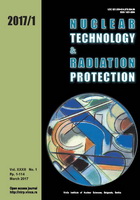
PREDICTION OF LONG-TERM INDOOR RADON CONCENTRATION BASED ON SHORT-TERM MEASUREMENTS
Pages: 77-84
Authors: Zdenka Stojanovska, Kremena Ivanova, Peter Bossew, Blazo Boev, Zora S. Žunić, Martina Tsenova, Zoran Ćurguz, Predrag Kolarž, Milka Zdravkovska, and Mimoza RistovaAbstract
We present a method for the estimation of annual radon concentration based on short-term (three months) measurements. The study involves results from two independent sets of indoor radon concentration measurements performed in 16 cities of the Republic of Macedonia. The first data set contains winter and annual radon concentration obtained during the National survey in 2010 and the second, contains only the radon concentration measured during the winter of 2013. Both data sets pertain to radon concentration from the same cities and have been measured applying the same methodology in ground floor dwellings. The results appeared to be consistent and the dispersion of radon concentration was low. Linear regression analysis of the radon concentration measured in winter of 2010 and of the 2010 annual radon concentration revealed a high coefficient of determination R2 = 0.92, with a relative uncertainty of 3%. Furthermore, this model was used to estimate the annual radon concentration solely from winter-term measurements performed in 2013.
The geometrical mean of the estimated annual radon concentration of the 2013: radon concentration (A-2013) =98 Bqm-3 was almost equal to the geometrical mean of the annual radon concentration from the 2010, radon concentration (A-2010) = 99 Bqm-3. Analysis of the influence of building characteristics, such as presence/absence of a basement in the building, or the dominant building material on the estimated annual radon concentration is also reported. Our results show that a low number of relatively short-term radon measurements may produce a reasonable insight into a gross average obtained in a larger survey.
Key words: ground floor dwelling, indoor radon, linear regression analysis, uncertainty
FULL PAPER IN PDF FORMAT (605 KB)
